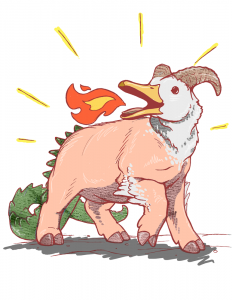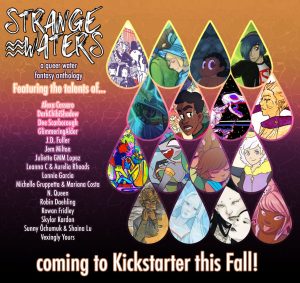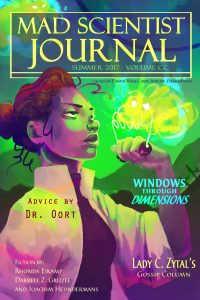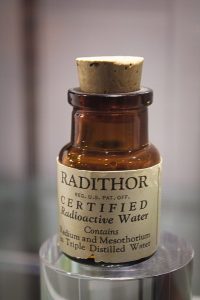An essay by S. M. Plathock, as provided by Rachel Rodman
Art provided by Leigh Legler
Introduction
For you, nature isn’t enough.
When you go outdoors and see something beautiful–a deer, say, backgrounded by trees–you feel all the normal stuff: awe, wonder, majesty, and blah, blah, blah.
But beneath that, not too far below the surface, you’re bored. BORED. Haven’t you already seen a deer? And haven’t you already seen a tree? And hasn’t everybody?
And beneath that, even stronger, is a need. A need to fuse and mash and link and blend and mix and change things.
Wouldn’t that deer be less boring, you wonder, if it were part shark? And wouldn’t those trees make you want to stab your eyes out, for sheer monotony, just a little bit less, if they were part Venus flytrap?
The answer to both these questions is, of course, “Yes.” Or possibly: “Hell, yes.” Or even: “Abso-friggin-lutely.”
You know it; I know it … even if not everyone else agrees. Even if your life, like mine, is full of negative, unhelpful people–your ex, your therapist, your parole officer, and so on–who don’t totally get it.
In this book, you will learn many wonderful and useful things:
- How to swap organs and tissues and chromosomes and genes.
- How to chop up different embryos into a cellular confetti, and then toss the pieces together again, to make fun new swirls.
- How to play “Trade you!” with eggs and sperm and fetuses and syringes full of blood.
- How to sew different bodies together, stitch by stitch, to make creatures with two heads.[1]
But, of all the spectacular and important lessons that are packed into this book, over the course of 12 chapters, the most important is this:
You shouldn’t listen to those people.
Let me say that again, in case it didn’t quite sink in:
You shouldn’t listen to those people.
Your dissatisfaction with nature is a deep and important part of you. And it is nothing to be ashamed of.
More to the point–and take it from someone who has tried–you couldn’t possibly stifle it, even if you wanted to.

So, make the leap. For the love of Pig-Ducks, just make the leap.
To read the rest of this story, check out the Mad Scientist Journal: Autumn 2018 collection.
S. M. Plathock stars in the documentary Nobody Puts the Great Pacific Octopus in the Corner (2013), which details her efforts to surgically suture herself to a giant mollusk; she is also the author of the philosophy treatise “Notes Towards an Überorganism” (2015), which promotes the compression of all of biodiversity into a single furry/scaled/ciliated whole.
A passionate proponent of interspecies surrogacy, Plathock is also excited to announce–as of Monday: pregnancy test positive!–that she is presently serving as prenatal host to a set of triplets: 1 desert hedgehog, 1 ring-tailed lemur, and 1 long-haired Persian kitten.
Rachel Rodman (www.rachelrodman.com) is a writer and a former scientist.
Leigh’s professional title is “illustrator,” but that’s just a nice word for “monster-maker,” in this case. More information about them can be found at http://leighlegler.carbonmade.com/.
“How to Build a Pig-Duck: The Do-It-Yourselfer’s Guide to Hybrids, Chimeras, and Synthetic Biology” is © 2018 Rachel Rodman
Art accompanying story is © 2018 Leigh Legler





 We’re on a comic book anthology kick right now, having just learned about
We’re on a comic book anthology kick right now, having just learned about  Now is the time to send us your tales from the world of mad science! We are looking for first person stories from 500-8,000 words that have some connection with mad science, though we use a loose definition of mad science that includes things like unicorns and dragons as well as beakers and test tubes. We are also looking for stories that would be of interest to mad scientists, told from any perspective, also in the 500-8,000 word range. And finally, we are looking for fictional classified ads in the 100-500 word range.
Now is the time to send us your tales from the world of mad science! We are looking for first person stories from 500-8,000 words that have some connection with mad science, though we use a loose definition of mad science that includes things like unicorns and dragons as well as beakers and test tubes. We are also looking for stories that would be of interest to mad scientists, told from any perspective, also in the 500-8,000 word range. And finally, we are looking for fictional classified ads in the 100-500 word range.
